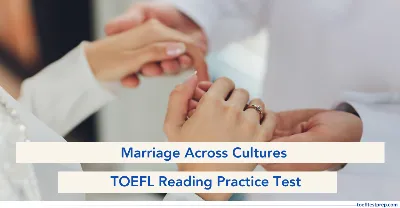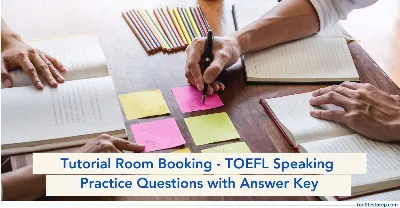Marriage Across Cultures - TOEFL iBT® Reading Practice Test

"Improve TOEFL Reading with passages on 'Marriage Across Cultures,' delving into unique traditions, values, and global perspectives on marriage."
Key Highlights
Marriage traditions vary widely across cultures, reflecting diverse values, beliefs, and societal norms. From ceremonial practices to the roles of partners, each culture adds a unique perspective to this universal institution.
Practising TOEFL Reading passages on 'Marriage Across Cultures' will help you navigate complex texts, understand diverse viewpoints, and prepare for questions related to societal structures and cultural exchanges.
Reading Instructions:
- You have 15 minutes to read the following passage and answer all 9 questions related to it.
- Most questions are worth 1 point, but the last question is worth more. The directions indicate how many points you will receive for that specific question.
- The specific section/paragraphs have been provided again with the question for ease of understanding and quick solution.
- Some questions include a word or phrase that is highlighted in the question as well as in the paragraph for quick reference.
Marriage Across Cultures
Marriage is a common practice that varies greatly across cultures, reflecting different social rules, religious beliefs, and historical contexts. While the main purpose of marriage often revolves around forming family ties and making offspring official, the customs and practices linked to marriage can differ widely. In many societies, marriage is not just a personal commitment between two people but an important agreement that involves families and communities. This complex nature of marriage shows its importance as a cultural event. It influences social structures, economic arrangements, and individual identities. Historical records show that marriage has changed over thousands of years, adapting to shifting community needs and values.
In Western cultures, marriage has traditionally been seen as a romantic union between two people, often marked by love and personal choice. The idea of marrying for love became popular in the 18th century, moving away from arranged marriages that were common in earlier times. However, even within Western societies, marriage practices can vary. For example, in Scandinavian countries, living together without formal marriage has become accepted, with studies indicating that nearly 50% of couples choose this arrangement. At the same time, the rise of same-sex marriage in many Western countries has sparked discussions about the changing definition of marriage, challenging long-held rules and broadening the understanding of family structures. This shift has led to legal changes and societal acceptance, showing the evolving nature of marriage in todays world.
In contrast, many non-Western cultures highlight family involvement in marriage arrangements. In countries like India and Pakistan, arranged marriages are common, where families play a key role in selecting partners based on factors like social status, social class, and economic stability. Research shows that about 90% of marriages in India are arranged. This reflects a strong cultural belief that family members have a better understanding of suitability and shared values. However, this practice comes with challenges. Individuals may struggle with the lack of personal choice in selecting their life partners. Critics argue that such arrangements can lead to issues of consent and personal happiness, raising questions about the balance between tradition and individual rights.
Also, cultural ceremonies surrounding marriage can vary widely. For example, in many African cultures, marriage ceremonies are grand events that can last several days, featuring various traditional ceremonies and community celebrations. The Maasai people of Kenya and Tanzania, for instance, have unique customs that include the exchange of cattle as a form of bride price, symbolizing wealth and social status. This practice not only strengthens family ties but also helps establish social standing within the community. In contrast, some Indigenous cultures in North America may include spiritual elements in their marriage ceremonies, emphasizing the connection between the couple and the natural world. These rituals not only bless the union but also reinforce cultural identity and community bonds, showcasing the diverse expressions of marriage across cultures.
The impact of globalization has also shaped marriage practices around the world. As cultures interact and mix, traditional customs may change or blend with new ideas. For instance, the growing number of intercultural marriageswhere partners come from different cultural backgroundshas led to mixed wedding ceremonies that include elements from both cultures. A study in urban areas of the United States found that nearly 15% of marriages are intercultural, highlighting the increasing acceptance of diverse marital arrangements. This blending of traditions can promote greater understanding and appreciation between communities, although it may also raise questions about cultural preservation and identity. Couples in these marriages often need to manage complex dynamics, balancing respect for their respective heritages with the desire to create a shared identity.
In conclusion, marriage across cultures reflects societal values, rules, and historical contexts. While marriage may share common purposes globally, the ways it is practiced and understood can vary greatly. As societies continue to evolve, so will the customs and meanings associated with marriage. The ongoing conversations about marriagewhether related to love, family involvement, or cultural ritualshighlight the dynamic nature of this institution. Also, the effects of globalization and intercultural interactions suggest that questions remain about the future of marriage practices. Ultimately, studying marriage across cultures not only enhances our understanding of human relationships but also emphasizes the importance of cultural diversity in shaping individual and collective identities.
Directions: Once you have read the passage, answer the following questions.
Paragraph 1
Marriage is a common practice that varies greatly across cultures, reflecting different social rules, religious beliefs, and historical contexts. While the main purpose of marriage often revolves around forming family ties and making offspring official, the customs and practices linked to marriage can differ widely. In many societies, marriage is not just a personal commitment between two people but an important agreement that involves families and communities. This complex nature of marriage shows its importance as a cultural event. It influences social structures, economic arrangements, and individual identities. Historical records show that marriage has changed over thousands of years, adapting to shifting community needs and values.
Factual Information Questions
- According to paragraph 1, what is one of the main purposes of marriage?
- To create economic arrangements
- To form family ties and make offspring official
- To reflect individual identities
- To establish social rules
Negative Factual Information Questions
- In paragraph 1, which of the following is NOT mentioned as a factor that influences marriage?
- Historical contexts
- Personal commitment
- Economic arrangements
- Political affiliations
Paragraph 2
In Western cultures, marriage has traditionally been seen as a romantic union between two people, often marked by love and personal choice. The idea of marrying for love became popular in the 18th century, moving away from arranged marriages that were common in earlier times. However, even within Western societies, marriage practices can vary. For example, in Scandinavian countries, living together without formal marriage has become accepted, with studies indicating that nearly 50% of couples choose this arrangement. At the same time, the rise of same-sex marriage in many Western countries has sparked discussions about the changing definition of marriage, challenging long-held rules and broadening the understanding of family structures. This shift has led to legal changes and societal acceptance, showing the evolving nature of marriage in todays world.
Inference Questions
- What can be inferred from paragraph 2 about the concept of marriage in Western cultures?
- It is solely based on economic factors.
- It has remained unchanged over the centuries.
- It has evolved to include diverse definitions and practices.
- It is primarily focused on family arrangements.
Rhetorical Purpose Questions
- Why does the author mention the rise of same-sex marriage in paragraph 2?
- To illustrate the historical context of marriage
- To highlight the evolving nature of marriage definitions
- To compare Western and non-Western marriage practices
- To argue against traditional marriage customs
Paragraph 3
In contrast, many non-Western cultures highlight family involvement in marriage arrangements. In countries like India and Pakistan, arranged marriages are common, where families play a key role in selecting partners based on factors like social status, social class, and economic stability. Research shows that about 90% of marriages in India are arranged. This reflects a strong cultural belief that family members have a better understanding of suitability and shared values. However, this practice comes with challenges. Individuals may struggle with the lack of personal choice in selecting their life partners. Critics argue that such arrangements can lead to issues of consent and personal happiness, raising questions about the balance between tradition and individual rights.
Vocabulary Questions
- In paragraph 3, the word "suitability" is closest in meaning to:
- Compatibility
- Availability
- Preference
- Agreement
Sentence Simplification Questions
- Which of the sentences below best expresses the essential information in the following text from paragraph 3?
"Research shows that about 90% of marriages in India are arranged."
- Most marriages in India are based on personal choice.
- A significant majority of marriages in India are arranged by families.
- Arranged marriages are uncommon in India.
- Families in India have little influence over marriage choices.
Paragraph 4
Also, cultural ceremonies surrounding marriage can vary widely. For example, in many African cultures, marriage ceremonies are grand events that can last several days, featuring various traditional ceremonies and community celebrations. The Maasai people of Kenya and Tanzania, for instance, have unique customs that include the exchange of cattle as a form of bride price, symbolising wealth and social status. This practice not only strengthens family ties but also helps establish social standing within the community. In contrast, some Indigenous cultures in North America may include spiritual elements in their marriage ceremonies, emphasising the connection between the couple and the natural world. These rituals not only bless the union but also reinforce cultural identity and community bonds, showcasing the diverse expressions of marriage across cultures.
Insert Missing Sentence Question
- In paragraph 4, there is a missing sentence. The paragraph is repeated below and shows four letters (A, B, C, and D) that indicate where the following sentence could be added.
"These ceremonies often involve the participation of the entire community."
Where would the sentence best fit?
(A) Also, cultural ceremonies surrounding marriage can vary widely. (B) For example, in many African cultures, marriage ceremonies are grand events that can last several days, featuring various traditional ceremonies and community celebrations. (C) The Maasai people of Kenya and Tanzania, for instance, have unique customs that include the exchange of cattle as a form of bride price, symbolising wealth and social status. (D) In contrast, some Indigenous cultures in North America may include spiritual elements in their marriage ceremonies, emphasising the connection between the couple and the natural world.
Paragraph 5
The impact of globalization has also shaped marriage practices around the world. As cultures interact and mix, traditional customs may change or blend with new ideas. For instance, the growing number of intercultural marriageswhere partners come from different cultural backgroundshas led to mixed wedding ceremonies that include elements from both cultures. A study in urban areas of the United States found that nearly 15% of marriages are intercultural, highlighting the increasing acceptance of diverse marital arrangements. This blending of traditions can promote greater understanding and appreciation between communities, although it may also raise questions about cultural preservation and identity. Couples in these marriages often need to manage complex dynamics, balancing respect for their respective heritages with the desire to create a shared identity.
Prose Summary Questions
- Directions: An introductory sentence for a brief summary of the passage is provided below. Complete the summary by selecting the THREE answer choices that express the most important ideas in the passage. Some sentences do not belong in the summary because they express ideas that are not presented in the passage or are minor ideas in the passage. This question is worth 2 points.
Marriage across cultures reflects societal values, rules, and historical contexts.
Answer Choices
- The customs and practices of marriage can differ widely across cultures.
- Globalisation has led to a blending of traditional marriage customs.
- Marriage is solely a personal commitment between two individuals.
- Arranged marriages are the most common form of marriage worldwide.
Paragraph 6
In conclusion, marriage across cultures reflects societal values, rules, and historical contexts. While marriage may share common purposes globally, the ways it is practiced and understood can vary greatly. As societies continue to evolve, so will the customs and meanings associated with marriage. The ongoing conversations about marriage whether related to love, family involvement, or cultural ritualshighlight the dynamic nature of this institution. Also, the effects of globalization and intercultural interactions suggest that questions remain about the future of marriage practices. Ultimately, studying marriage across cultures not only enhances our understanding of human relationships but also emphasizes the importance of cultural diversity in shaping individual and collective identities.
Purpose of the Passage Questions
- What is the main purpose of paragraph 6?
- To summarise the key points about marriage across cultures
- To argue against traditional marriage practices
- To provide a historical overview of marriage
- To discuss the future of marriage in Western societies
Prose Summary Questions
- Directions: An introductory sentence for a brief summary of the passage is provided below. Complete the summary by selecting the THREE answer choices that express the most important ideas in the passage. Some sentences do not belong in the summary because they express ideas that are not presented in the passage or are minor ideas in the passage. This question is worth 2 points.
Marriage across cultures reflects societal values, rules, and historical contexts.
Answer Choices
- The customs and practices of marriage can differ widely across cultures.
- Globalisation has led to a blending of traditional marriage customs.
- Marriage is solely a personal commitment between two individuals.
- Arranged marriages are the most common form of marriage worldwide.
Answer Key with Explanation for TOEFL Reading Passage - Marriage Across Cultures
Here are the answers and explanations for the questions based on the provided passage:
1. Answer: B
Explanation: The passage explicitly states that one of the main purposes of marriage revolves around forming family ties and making offspring official. This aligns with the broader context of marriage as a cultural event that influences social structures and individual identities.
2. Answer: D
Explanation: The passage mentions social rules, religious beliefs, historical contexts, and economic arrangements as factors influencing marriage. However, political affiliations are not mentioned at all, making option D the correct answer.
3. Answer: C
Explanation: The passage discusses how the concept of marriage in Western cultures has changed over time, particularly with the rise of same-sex marriage and cohabitation without formal marriage. This indicates that the definition and practices surrounding marriage have evolved to be more inclusive and diverse.
4. Answer: B
Explanation: The mention of same-sex marriage serves to illustrate how the definition of marriage is changing in Western societies. It highlights the ongoing discussions and legal changes that reflect a broader understanding of family structures, which is central to the paragraph's focus.
5. Answer: A
Explanation: In the context of the passage, "suitability" refers to the appropriateness or compatibility of partners in arranged marriages. This aligns closely with option A, as it implies a match based on shared values and social status.
6. Answer: B
Explanation: This option accurately captures the essence of the original sentence, which states that about 90% of marriages in India are arranged. It conveys the idea that family involvement is a significant factor in these marriages.
7. Answer: B
Explanation: The missing sentence fits best after the first sentence in paragraph 4, as it introduces the idea that cultural ceremonies often involve community participation. This enhances the description of the grand events mentioned in the following sentence.
8. Answer Choices: A, B, D
Explanation: A is correct as it reflects the diversity of marriage customs across cultures.
B is correct as it addresses the impact of globalization on marriage practices.
D is incorrect because while arranged marriages are common in some cultures, the passage does not state they are the most common form worldwide.
C is incorrect as the passage emphasizes that marriage is not solely a personal commitment.
9. Answer: A
Explanation: The main purpose of paragraph 6 is to summarise the various aspects of marriage discussed throughout the passage, including its cultural significance and the impact of globalization. It encapsulates the key themes presented in the earlier paragraphs.
10. Answer Choices: A, B
Explanation: A is correct as it highlights the diversity of marriage customs.
B is correct as it addresses the blending of traditional customs due to globalization.
C and D are incorrect as they misrepresent the passage's content regarding the nature of marriage.
Also Read:
- The History of Astronomy - TOEFL Reading Practice Test with Answers
- Grammar At Deeper Level - TOEFL Reading Practice Test With Answer
- Human Aggression - TOEFL iBT® Reading Practice Questions with Answer Key
- Swimming Devices - TOEFL iBT® Reading Practice Questions with Answer Key
- Earth and Its Landscape - TOEFL iBT® Reading Practice Questions with Answer Key
Featured Articles

Marriage Across Cultures - TOEFL Reading Practice Test
Improve TOEFL Reading with passages on 'Marriage Across Cultures,' delving into unique traditions, values, and global perspectives on marriage.
July 15, 2025
Writing Center Services - TOEFL Speaking Practice Test with Answers (Integrated)
Prepare for the TOEFL Integrated Speaking section with a practice test on 'Writing Center Services' and learn to improve score in TOEFL exam.
July 15, 2025
Tutorial Room Booking - TOEFL Speaking Practice Test with Answers (Integrated)
Prepare for the TOEFL Integrated Speaking section with a practice test on 'Tutorial Room Booking ' and learn to improve score in TOEFL exam.
July 15, 2025
Textbook Rental System - TOEFL Speaking Practice Test with Answers (Integrated)
Prepare for the TOEFL Integrated Speaking section with a practice test on 'Textbook Rental System' and learn to improve score in TOEFL exam.
July 15, 2025